Navigation
Remote waters affect billions of people, shape climate and air chemistry worldwide
.jpg) Scientists working on the CONTRAST project will be in the field this month and next.: Photograph from NSF-NCAR courtesy of NSF.
Scientists working on the CONTRAST project will be in the field this month and next.: Photograph from NSF-NCAR courtesy of NSF.
Scientists working on the CONTRAST project will be in the field in January and February 2014.
Although few people live in the Western tropical Pacific Ocean region, the remote waters there affect billions of people by shaping climate and air chemistry worldwide.
Equipped with high-speed, high-resolution video, researchers discovered how the larvae of Atlantic slipper limpets, marine snails, swim, a behavior that determines individual dispersal and ultimately, survival.
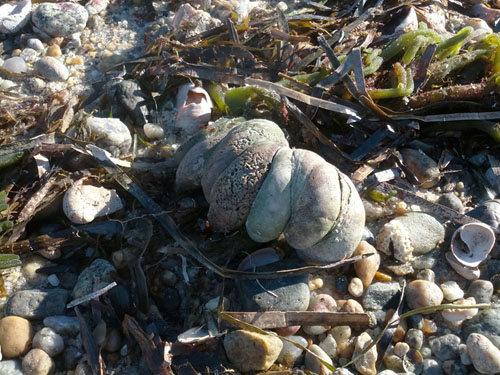 Atlantic slipper limpets are common marine snails native to the northeastern U.S. coast.: Photograph by Karen Chan, WHOI courtesy of NSF
Atlantic slipper limpets are common marine snails native to the northeastern U.S. coast.: Photograph by Karen Chan, WHOI courtesy of NSF
Walk the beach or peer into a tidepool anywhere along the northeastern U.S. coast, and you'll find shells stacked on top of one another. They're most likely common Atlantic slipper shells, a species of marine snail.
Yale Himalaya Initiative (YHI) with a focus on the themes of Environment, Livelihood and Culture brings together diverse disciplinary interests to consider critical questions in the Himalaya and beyond.
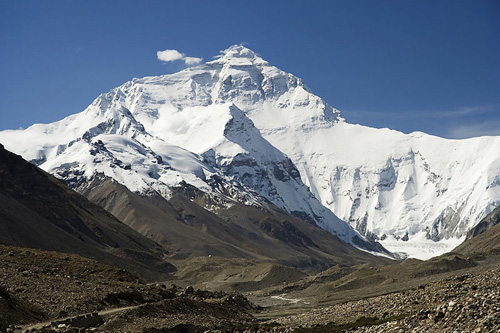 Mount Everest North Face as seen from the path to the base camp, Tibet.: Cara norte del Monte Everest vista desde el sendero que lleva al campo base en el Tibet (China). Face nord du Mont Everest vue du chemin menant au camp de base. Tibet. Faccia Nord del monte Everest vista dal sentiero che porta al campo base in Tibet. Photograph by Luca Galuzzi (Lucag) courtesy of Wikipedia
Mount Everest North Face as seen from the path to the base camp, Tibet.: Cara norte del Monte Everest vista desde el sendero que lleva al campo base en el Tibet (China). Face nord du Mont Everest vue du chemin menant au camp de base. Tibet. Faccia Nord del monte Everest vista dal sentiero che porta al campo base in Tibet. Photograph by Luca Galuzzi (Lucag) courtesy of Wikipedia
- Afghanistan
- China and Tajikistan
- chiru
- conservation
- disease
- Dr. Stephane Ostrowski
- game reserves
- George B. Schaller
- gorilla
- health
- lion
- Marco Polo sheep
- National Geographic
- Pakistan
- Pamir Mountains
- panda
- Peking University
- pika
- Rwanda
- Sanjiangyuan National Nature Reserve
- snow leopard
- Tarun Tejpal
- Tibet Wild
- tiger
- Virunga National Park
- Wildlife Conservation Society
- Biodiversity
- Endangered Species
- Forests
- Global Climate Change
George B. Schaller shares special moments throughout his book Tibet Wild: A Naturalist's Journeys on the Roof of the World, and tells of his connections with animals in ways that can benefit others in their pursuit of animal preservation. There are more than 20 game reserves around the world stemming from Schaller’s work.
 500hr.jpg) George Schaller on the Tibetan Plateau.: Photograph from Tibet Wild by George B. Schaller. Reproduced by permission of Island Press.
George Schaller on the Tibetan Plateau.: Photograph from Tibet Wild by George B. Schaller. Reproduced by permission of Island Press.
“There are wonderful moments.
One day I was siting on a branch observing one of the groups of gorillas and a female gorilla came up on to the branch and sat next to me.
- Agencies
- Aichi
- America's Cup Healthy Ocean Project
- Arctic
- biodiversity
- Callum Roberts
- Caribbean
- Carl Gustaf Lundin
- climate
- Dr. Sylvia Earle
- ecosystems
- Editorial
- Films
- Global Partnership for Oceans
- High Seas
- IMPAC 3
- Invasive Alien Species
- IUCN
- marine protected areas
- Marseille
- Mediterranean
- National Geographic
- Oceankind
- oceans
- Pacific
- Program UNEP
- Protect Planet Ocean
- Sylvia Earle Alliance
- TED
- UNESCO
- Biodiversity
- Endangered Species
- Oceans, Coral Reefs
- Pollution
On October 22, 2013, news coming from the 3rd International Marine Protected Areas Congress (IMPAC 3) reported that Dr. Sylvia Earle, Mission Blue and the International Union for Conservation of Nature (IUCN), have launched 31 new Mission Blue Hope Spots -- places of special significance in the ocean where Mission Blue will focus its efforts. There are now 50 Hope Spots globally. Mission Blue calls this “a path forward for protecting our Blue Heart.”
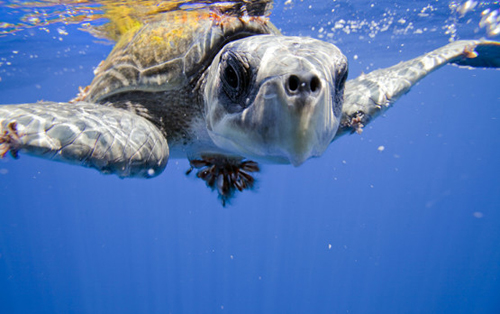 The Eastern Pacific Seascape spans Central and South America, covering a total of 2 million square kilometers.: Photograph© Kip Evans / Mission Blue (Cocos)
The Eastern Pacific Seascape spans Central and South America, covering a total of 2 million square kilometers.: Photograph© Kip Evans / Mission Blue (Cocos)
In his Prologue to his book “Ocean of Life: The Fate of Man and the Sea,” Callum Roberts writes:
United Nations Educational, Scientific and Cultural Organization (UNESCO), decided yesterday to establish a research center in Sweden with a focus on international water issues. With its focus on transboundary water cooperation, the center will be one of a kind. The center will be run by the Stockholm International Water Institute (SIWI) in collaboration with Uppsala University and the University of Gothenburg.
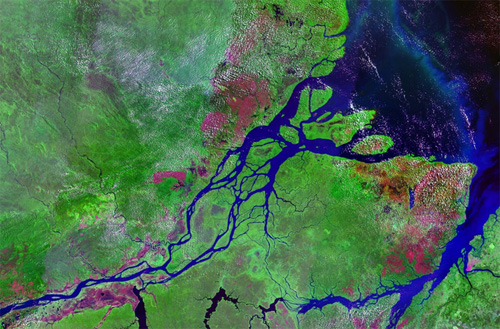 The Amazon River in South America is generally regarded as the second longest river in the world and is: by far the largest by water flow with an average discharge of about 209,000 cubic meters per second. The Amazon runs through Brazil, Columbia and Peru. Text and image courtesy of Wikipedia
The Amazon River in South America is generally regarded as the second longest river in the world and is: by far the largest by water flow with an average discharge of about 209,000 cubic meters per second. The Amazon runs through Brazil, Columbia and Peru. Text and image courtesy of Wikipedia
- Agriculture
- arsenic
- Bloomberg School of Public Health
- Center for Food Safety
- chickens
- Consumer Reports
- European Food Safety Authority
- factory farming
- Fleming Labs
- Food and Drug Administration
- Johns Hopkins Center for a Livable Future
- Keeve Nachman
- Nicolas D. Kristof
- pigs
- turkeys
- WHO
- Zoetis
- Global Health
- Industry
- Pollution
At the request of two drug companies, the Food and Drug Administration (FDA) has announced that it will withdraw approvals for three of four arsenic-based drugs currently approved for use in food animal production. A fourth arsenic-based drug used to make turkeys and chickens grow faster, among other purposes, will remain on the market.
Center for a Livable Future Science Director Discusses Roxarsone at Press Conference
In an attempt to improve the sustainable management of global water resources, the United Nations Environment Programme (UNEP), in collaboration with the United Nations University Institute for Environment and Human Security (UNU-EHS) and the Global Water Systems Project (GWSP), launched the International Water Quality Guidelines for Ecosystems (IWQGES) project on October 10, 2013, at the Budapest Water Summit.
This comprehensive project will address both issues of water quality, including chemical, biological, and biodiversity aspects and issues of water quantity including availability, changes over time and morphology of bodies of water.
WHO and Health Care Without Harm have joined forces to launch a new initiative to get mercury removed from all medical measuring devices by 2020 by ending the manufacture, import and export of these devices and by supporting the deployment of accurate, affordable, and safer non-mercury alternatives.
A unique housing arrangement between a specific tree species and carbo-loading bacteria may determine how well tropical forests can absorb carbon dioxide from the atmosphere, says new research from 16 September 2013 in an advance online publication of the journal Nature.
3.jpg) Tropical rainforest on Barro Colorado Island, Panama, near the site of the study.: Photograph by Marcos Guerra, STRI
Tropical rainforest on Barro Colorado Island, Panama, near the site of the study.: Photograph by Marcos Guerra, STRI
A unique housing arrangement between a specific tree species and carbo-loading bacteria may determine how well tropical forests can absorb carbon dioxide from the atmosphere, says new research from 16 September 2013 in an advance online publication of the journal Nature.
An exploration of groundwater resources has identified reserves of water in Turkana County in drought-stricken northern Kenya. Of Kenya’s 41 million people, 17 million lack access to safe water and 28 million do not have adequate sanitation.
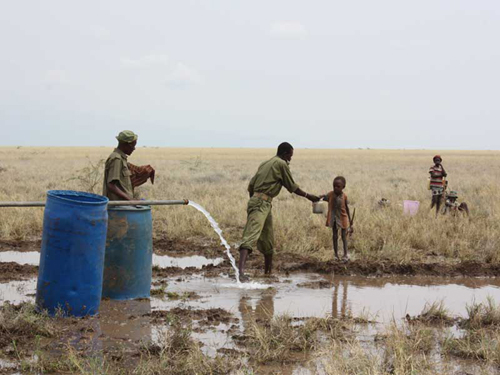 A Kenya Police Reservist delivers clean water to a thirsty child at the Lotikipi Borehole.: Photograph © UNESCO/Nairobi Office
A Kenya Police Reservist delivers clean water to a thirsty child at the Lotikipi Borehole.: Photograph © UNESCO/Nairobi Office
An exploration of groundwater resources has identified reserves of water in Turkana County in drought-stricken northern Kenya.
“Elephants across Africa and Asia are being poached for their ivory at increasing levels,” says WWF. Fortunately, there are many local human populations, national and international organizations and governments in the world often working together to save elephants and their habitats, groups in Asia and Africa, and even with elephant sanctuaries in the United States.
“Nature’s great masterpiece, an elephant,
The only harmless great thing.”
John Donne from “Progress of the Soul,” 1601 st. 39
 A family of African elephants in Amboseli National Park: note the protected position of the calves in the middle of the group: Photograph by Amoghavarsha Courtesy of Wikipedia
A family of African elephants in Amboseli National Park: note the protected position of the calves in the middle of the group: Photograph by Amoghavarsha Courtesy of Wikipedia
Climate change is already affecting the spread of infectious diseases--and human health and biodiversity worldwide--according to disease ecologists reporting research results in the August 2, 2013 issue of the journal Science. Modeling disease outcomes from host and parasite responses to climate variables, they say, could help public health officials and environmental managers address the challenges posed by the changing landscape of infectious disease.
Study highlights challenges of predicting disease outcomes in a warming world
Support for a sustainable management program at Macaya National Park: A $9 million grant will help Haiti carry out a sustainable land management program at the Macaya National Park, home to one of the country’s largest remaining forests, the Inter-American Development Bank (IDB) announced on 1 August 2013.
[img_assist|nid=1071|title=Pic Macaya National Park (French: Parc National Pic Macaya) is one of two national parks of the Republic of Haiti,|desc=the other is La Visite National Park. It is located on the peninsula in the southern part of the country, and features the country's last stand of virgin cloud forest. Elevations in the rugged park reach a maximum height of 2,347 meters (7,700 feet) above sea level at Pic Macaya (Macaya Peak), the second highest point in Haiti behind Pic la Selle. The mountains are mainly karstic and volcanic.
The U.S. Environmental Protection Agency (EPA) today announced changes to its Integrated Risk Information System (IRIS) Program to improve the scientific foundation of assessments. IRIS is a human health assessment program that evaluates information on health effects that may result from exposure to environmental contaminants.
 IRIS
IRIS
.JPG)
“The geckos stuck just as well under water as they did on a dry surface, as long as the surface was hydrophobic [water-loving],” Stark explains. “We believe this is how geckos stick to wet leaves and tree trunks in their natural environment.”
The study has implications for the design of a synthetic gecko-inspired adhesive. Geckos' ability to stick to trees and leaves during rainforest downpours has fascinated scientists for decades, leading a group of University of Akron researchers to solve the mystery.
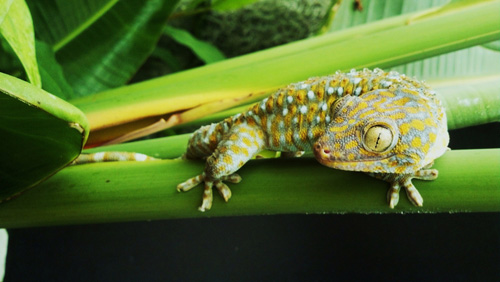 Geckos maintain their grip on wet hydrophobic surfaces such as those of leaves and tree trunks.: This discovery was made by University of Akron researcher, integrated bioscience doctoral candidate Alyssa Stark, principal investigator, and her colleagues Ila Badge, Nicholas Wucinich, Timothy Sullivan, Peter Niewiarowski and Ali Dhinojwala. Photograph by Alyssa Stark of The University of Akron
Geckos maintain their grip on wet hydrophobic surfaces such as those of leaves and tree trunks.: This discovery was made by University of Akron researcher, integrated bioscience doctoral candidate Alyssa Stark, principal investigator, and her colleagues Ila Badge, Nicholas Wucinich, Timothy Sullivan, Peter Niewiarowski and Ali Dhinojwala. Photograph by Alyssa Stark of The University of Akron
Increasing levels of atmospheric carbon dioxide alter how plants use water: Spurred by increasing levels of atmospheric carbon dioxide, forests over the last two decades have become dramatically more efficient in how they use water. "Findings from this study are important to our understanding of forest ecosystems--and how they can be managed more effectively now and in the future."
 A sonic aerometer for monitoring gas exchange between the forest and the atmosphere.: Photograph by Chris Vogel
A sonic aerometer for monitoring gas exchange between the forest and the atmosphere.: Photograph by Chris Vogel
Spurred by increasing levels of atmospheric carbon dioxide, forests over the last two decades have become dramatically more efficient in how they use water.
Scientists affiliated with the National Science Foundation's (NSF) Harvard Forest Long-Term Ecological Research (LTER) site report the results in this week's issue of the journal Nature.
The footage was captured on April 23 this year, and shows Oyster 800 in waves over eight metres high at the European Marine Energy Centre in Orkney. "The big challenge in designing and building a wave machine is ensuring it can survive in massive waves. The video gives a good example of what we need to design for," says Aquamarine Power Chief Executive Officer Martin McAdam.
Oyster 800 wave machine in massive waves
Aquamarine Power has just released new video footage showing their Oyster 800 wave energy machine operating in massive waves off Orkney.
- Antarctic Circumpolar Current
- Antarctica
- Chicago
- Icefish
- Lights Camera Action
- Lindblom Math and Science Academy
- LLC
- Lockheed Martin Corp
- marine engineers
- National Science Foundation
- NSF
- NSF/PolarTREC
- Remotely Operated Vehicles
- Southern Ocean
- students
- teacher
- Underwater camera
- US
- Biodiversity
- Global Climate Change
- Oceans, Coral Reefs
The icy Southern Ocean that surrounds Antarctica is about as cold, stormy and inhospitable a body of water as can be imagined. But thanks to the ingenuity of a group of high-school students, their teacher and a miniature video camera on a cable, it has also become a real-life classroom for budding marine engineers.
Search
Latest articles
Agriculture
- World Water Week: Healthy ecosystems essential to human health: from coronavirus to malnutrition Online session Wednesday 24 August 17:00-18:20
- World Water Week: Healthy ecosystems essential to human health: from coronavirus to malnutrition Online session Wednesday 24 August 17:00-18:20
Air Pollution
- "Water and Sanitation-Related Diseases and the Changing Environment: Challenges, Interventions, and Preventive Measures" Volume 2 Is Now Available
- Global Innovation Exchange Co-Created by Horizon International, USAID, Bill and Melinda Gates Foundation and Others
Biodiversity
- World Water Week: Healthy ecosystems essential to human health: from coronavirus to malnutrition Online session Wednesday 24 August 17:00-18:20
- Mangrove Action Project Collaborates to Restore and Preserve Mangrove Ecosystems
Desertification
- World Water Week: Healthy ecosystems essential to human health: from coronavirus to malnutrition Online session Wednesday 24 August 17:00-18:20
- UN Food Systems Summit Receives Over 1,200 Ideas to Help Meet Sustainable Development Goals
Endangered Species
- Mangrove Action Project Collaborates to Restore and Preserve Mangrove Ecosystems
- Coral Research in Palau offers a “Glimmer of Hope”
Energy
- Global Innovation Exchange Co-Created by Horizon International, USAID, Bill and Melinda Gates Foundation and Others
- Wildlife Preservation in Southeast Nova Scotia
Exhibits
- Global Innovation Exchange Co-Created by Horizon International, USAID, Bill and Melinda Gates Foundation and Others
- Coral Reefs
Forests
- NASA Satellites Reveal Major Shifts in Global Freshwater Updated June 2020
- Global Innovation Exchange Co-Created by Horizon International, USAID, Bill and Melinda Gates Foundation and Others
Global Climate Change
- World Water Week: Healthy ecosystems essential to human health: from coronavirus to malnutrition Online session Wednesday 24 August 17:00-18:20
- Mangrove Action Project Collaborates to Restore and Preserve Mangrove Ecosystems
Global Health
- World Water Week: Healthy ecosystems essential to human health: from coronavirus to malnutrition Online session Wednesday 24 August 17:00-18:20
- More than 400 schoolgirls, family and teachers rescued from Afghanistan by small coalition
Industry
- "Water and Sanitation-Related Diseases and the Changing Environment: Challenges, Interventions, and Preventive Measures" Volume 2 Is Now Available
- Global Innovation Exchange Co-Created by Horizon International, USAID, Bill and Melinda Gates Foundation and Others
Natural Disaster Relief
- STOP ATTACKS ON HEALTH CARE IN UKRAINE
- Global Innovation Exchange Co-Created by Horizon International, USAID, Bill and Melinda Gates Foundation and Others
News and Special Reports
- World Water Week: Healthy ecosystems essential to human health: from coronavirus to malnutrition Online session Wednesday 24 August 17:00-18:20
- STOP ATTACKS ON HEALTH CARE IN UKRAINE
Oceans, Coral Reefs
- World Water Week: Healthy ecosystems essential to human health: from coronavirus to malnutrition Online session Wednesday 24 August 17:00-18:20
- Mangrove Action Project Collaborates to Restore and Preserve Mangrove Ecosystems
Pollution
- Zakaria Ouedraogo of Burkina Faso Produces Film “Nzoue Fiyen: Water Not Drinkable”
- "Water and Sanitation-Related Diseases and the Changing Environment: Challenges, Interventions, and Preventive Measures" Volume 2 Is Now Available
Population
- "Water and Sanitation-Related Diseases and the Changing Environment: Challenges, Interventions, and Preventive Measures" Volume 2 Is Now Available
- "Water and Sanitation-Related Diseases and the Changing Environment: Challenges, Interventions, and Preventive Measures" Volume 2 Is Now Available
Public Health
- Honouring the visionary behind India’s sanitation revolution
- Honouring the visionary behind India’s sanitation revolution
Rivers
- World Water Week: Healthy ecosystems essential to human health: from coronavirus to malnutrition Online session Wednesday 24 August 17:00-18:20
- Mangrove Action Project Collaborates to Restore and Preserve Mangrove Ecosystems
Sanitation
- Honouring the visionary behind India’s sanitation revolution
- Honouring the visionary behind India’s sanitation revolution
Toxic Chemicals
- "Water and Sanitation-Related Diseases and the Changing Environment: Challenges, Interventions, and Preventive Measures" Volume 2 Is Now Available
- Actions to Prevent Polluted Drinking Water in the United States
Transportation
- "Water and Sanitation-Related Diseases and the Changing Environment: Challenges, Interventions, and Preventive Measures" Volume 2 Is Now Available
- Urbanization Provides Opportunities for Transition to a Green Economy, Says New Report
Waste Management
- Honouring the visionary behind India’s sanitation revolution
- Honouring the visionary behind India’s sanitation revolution
Water
- Honouring the visionary behind India’s sanitation revolution
- Honouring the visionary behind India’s sanitation revolution
Water and Sanitation
- Honouring the visionary behind India’s sanitation revolution
- Honouring the visionary behind India’s sanitation revolution

